By Gideon Levy and Alex Levac. Published in Haaretz on August 30, 2019.
Settlers have taken over dozens of springs in the West Bank, all of them on private Palestinian land, and are keeping the owners away. Rina Shnerb, a Jewish teen, was murdered last week at one of them.
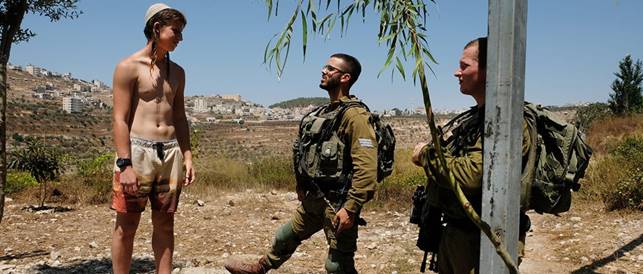
What could be more idyllic than the sight of a natural bubbling spring amid craggy boulders, welling up from the hills, its crystalline waters flowing silently into a small pool where people are cavorting in delight? What could be more innocent than parents and children splashing about in a natural pond of greenish water, the gurgling of the water mingling with yelps of joy? And what could be more moving than the sign next to one of these springs of salvation: “Dear hikers, Welcome to Anar Springs, built thanks to an intensive effort by the youth of [the nearby settlement of] Niria. Lovers of this place, we have one small request: to dress in a way that respects all visitors, based on consideration for the needs of the Other. We built the site for your sake and for the sake of the people of Israel. Our goal is for everyone to hike and enjoy the springs together.”
The heart swells at the words “lovers of this place,” “consideration for the needs of the Other,” “enjoy the springs together.” Mankind is happy, nature is spectacular, but this spring, like all the others like it in the West Bank, was stolen from its owners. Robbed. Plundered. With a stomach-churning crudeness and violence. The “everyone” and the “consideration” – those words refer to Jews only.
In these apartheid springs, stolen waters shall not be sweetened. Palestinian owners of these lands can only look on despairingly from the windows of their homes at their neglected olive groves, which they were forced to abandon to the insatiable greed of the lords of the land, and at the gushing springs nearby that were also stolen from them. The groves are gone, the springs are gone, justice is gone. And all, of course, under the aegis of the state and its institutions.
According to Dror Etkes, the founder of Kerem Navot, an organization that studies Israeli land policy in the West Bank, there are today more than 60 springs in the central West Bank that settlers coveted and seized as part of a project of plunder that began 10 years ago. The landscaping and renovation work at about half of them has been completed, the dispossession made absolute, the Palestinians blocked from even approaching the springs and their lands. Other springs targeted by the settlers are in various stages of takeover.
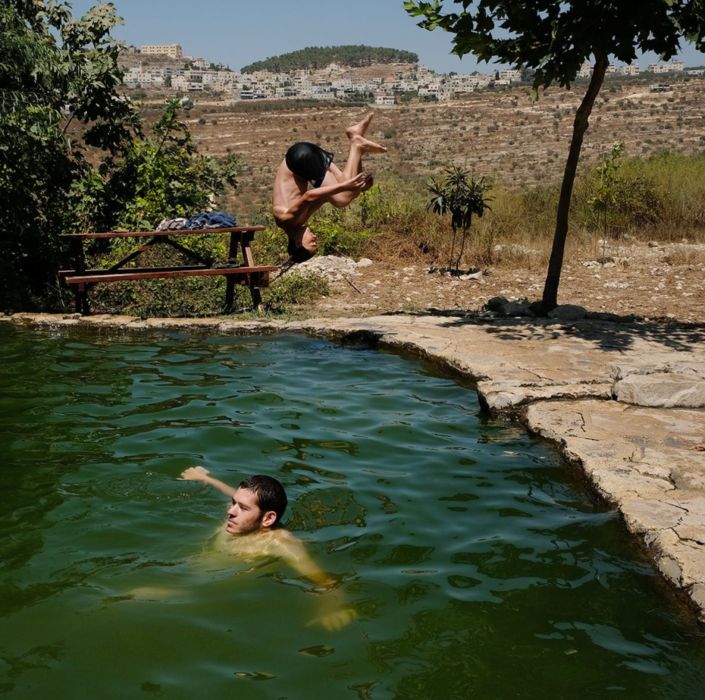
Etkes explains that the seizure of the springs is part of an ambitious plan of a far larger scope – to take control of the remaining open spaces in the West Bank. This is being done by way of creation of bathing areas and hiking trails, designation of graves of Jewish spiritual figures as “holy sites,” and development of picnic sites, all on Palestinian-owned private land. The aim: to isolate the Palestinian villages, instead of isolating settlements, and of course to seize more and more land.
Last Friday this criminal undertaking claimed a high price: The gurgling waters were tainted with red – the blood of Rina Shnerb, a teenager who was killed by an improvised explosive device that had been planted next to the Ein Bubin spring; her father and brother were also wounded in the blast.
We wandered the land of the springs this week escorted by Etkes, who’s intimately familiar with the territory. (In 2012, Etkes wrote a report on the theft of natural springs for OCHA, a United Nations agency dealing with humanitarian affairs.) He knows about every new sheep pen that settlers have built secretly and is familiar with every boulder.
The sights were enthralling, but the truth behind them – is enough to make the blood boil. Many of these stolen springs were deserted this week, despite the “between the times” break for yeshiva students, perhaps due to fear in the wake of the attack at Ein Bubin, which is situated near the settlement of Dolev and the Palestinian village of Deir Ibzi. A long rocky path there leads to the site that settlers call Danny’s Spring, named for Danny Gonen, a student who was killed four years ago, after taking a dip.
The settlers built the hillside path down to the fertile valley without authorization, of course. It runs through a grove of olive trees that belong to farmers from Deir Ibzi. The trees are now neglected and forsaken, the soil around them is uncultivated and thorny bushes have sprung up. The farmers are allowed access to their property only two or three days a year, as its forlorn state testifies. The whole descent into the valley where the spring gushes has been plundered. A spring, a sandy trail – a languishing grove. A few armed soldiers suddenly dart out at us from among the olive trees about halfway down the deserted path. No entry, closed military zone!
Back on the main road, a large Israeli flag flaps in the wind. Welcome to the Dolev-Talmonim bloc of settlements. The grove owned by farmers from the nearby village of Al-Janiya has also been ruined. Their natural spring, Ein al-Masraj, in the grove’s center, is now known as Ein Talmon and the path leading there passes through the fenced-off territory of the Talmon settlement and its array of unauthorized satellite “neighborhoods.” The Jewish National Fund declares that this is the “circuit trail around Talmonim Springs.” The neglected olive trees alongside the path that’s blocked to Palestinians are ancient, withering. The stolen spring looks well-tended, but heaps of garbage are piled up around it unmercifully.
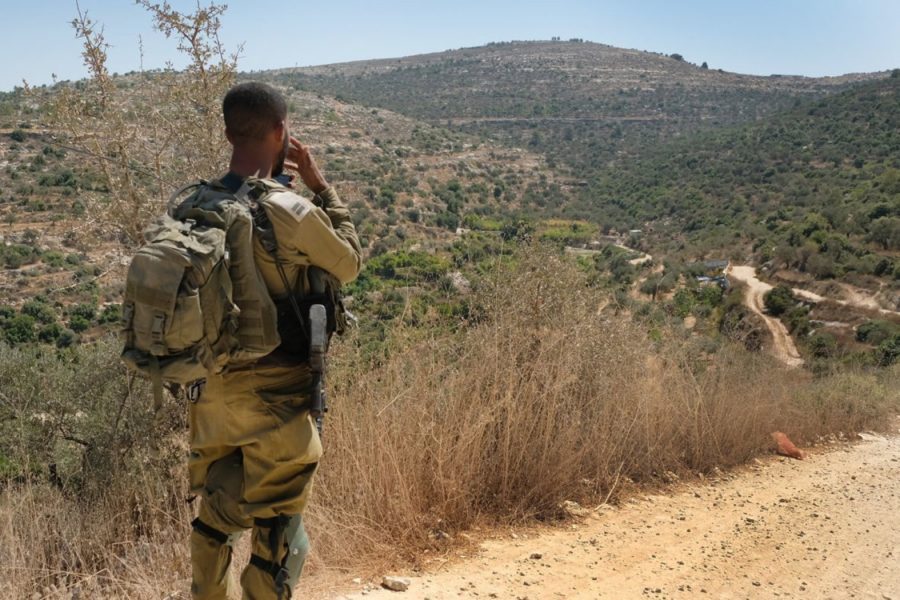
A youngish-looking woman and three girls from Dolev are taking a dip there, fully clothed and kerchiefed. The girls call her grandma. A shopping bag from the Rami Levy supermarket lies on the ground. Gender separation is de rigueur at these springs; the woman offers to come out of the water so that we can enter. The ruins of a Palestinian farmhouse nearby bear mute witness to a past that’s gone forever. “A Jew doesn’t refrigerate another Jew,” is the graffiti scrawled on a wall.
Talmon cuts off the grove from the Palestinian village to which it belongs. “Circle, circle, circle, let’s celebrate in a circle, sit down, sit down and stand up,” the woman and girls sing gaily. An empty Doritos bag rolls across the ground. Teenage settlers are sitting at a JNF picnic table wearing T-shirts with the inscription, “the running experience in biblical landscapes.” The settler outpost above us is called Givat Habreicha (Hill of the Pool). Villas with a view to the water. A military base has been erected in the settlement, for security purposes.
The signs in the olive grove belonging to Mazra’a al-Kibiliya, east of the Talmons, lead to something called Vineyard Hill. This whole surrealistic scene is topped off by a huge elephant made of polyester atop the hill. Between the homes of Mitzpeh Haresha are signs leading to Haresha Spring. “To the new families: Welcome, in God’s name. We are happy at your arrival. With love, the family of Haresha.”
In the name of God and for the sake of love, they also stole this spring in the valley.
A soldier darts out, a child rides a swing, a vehicle of the Israel Defense Forces on which is mounted a mysterious device scans the valley where the attack occurred last Friday. Haresha Spring is very close to the homes of Mazra’a al-Kibiliya and it’s dangerous to go there, a soldier tells us. Settlers go there armed. Yet another spring that no longer belongs to its owners. “A spring with two cool, crystalline streams, usually three meters full,” the settlers’ Land of the Springs portal promises. “Thanks to the youth of Neria, the neighboring community, for the information.”
We ascend to Zayit Ra’anan (literally, “fresh olive”), another settler outpost of Talmon. Yes, there really is such a place. Not far from it is a sheikh’s tomb, Nebi Anar, and after it the trail descends through forcibly abandoned olive groves to the Anar Springs, whose original names are Ein a-Shuna and Ein al-Batama. Settlers have built three pools in a row here and, as at similar sites, everything is splendidly constructed and well-tended. There’s even a sign with a phone number to call in an emergency. Ma’ayan Hagefen, Ma’ayan Hana’arim, Ma’ayan Neria: The pools are shaded by grapevines. Abutting them is a grove of fruit trees owned by Palestinians.
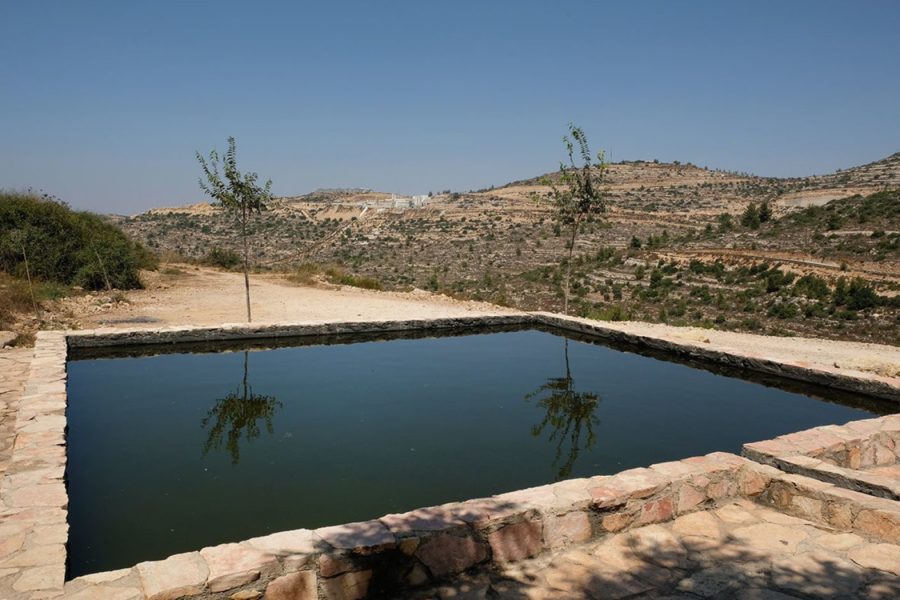
A group of teens from Neria and Dolev are in the water. They’re talking about the prime minister’s promise to build 300 homes in Dolev, a consolation prize for the attack last Friday. “‘Bro, it’s like his promise to build 300 homes in Beit El,” one youth says dismissively. This is the pool-side conversation.
The multistory homes of the village of Deir Amar overlook the pools; from every window villagers can see the young settlers frolicking in their lost spring. It’s not hard to imagine what they are feeling. Here, too, the Palestinians’ trees are a pitiful sight; they seem to be begging for help.
“Two more springs are going to be built here, ‘bro,” one of the young people in the water says. “My dad heard the explosion on Friday. You could see the ambulances arriving from our balcony.”
A supermarket bag is lying next to the third pool in the row. A group from the religious-Zionist newspaper Makor Rishon is here to do a story on the springs. They will certainly take a totally different viewpoint. Arab music from the houses of Deir Amar wafts softly across the valley. Construction of the road leading here was also unauthorized. The settlers didn’t even bother to expropriate the land, Etkes notes; they simply paved the road as though the property was theirs.
In the morning, on the way here, opposite the settlement of Nili, Etkes suddenly jumped up in the driver’s seat as though bitten by a snake: He noticed a large pen for livestock that wasn’t here just a few days earlier. A storage area for grain, a truck for sleeping in, a generator and a water container – another settler outpost is about to be established, along with annexation of large parts of pasture land for the benefit of the new shepherds.
Meanwhile, above Anar Springs, a bulldozer is clearing land in Neria. Heading north en route to the settler outposts of Kerem Re’im and Nahliel are picnic tables in a deserted grove. We turn off the road toward Wadi al-Zarka, aka the Blue Valley. A sign of the UN development agency from 2018 hints that this is the only place where the settlers failed in their takeover bid: They tried to seize the spring on the slope of the hill above, but the permanent presence of Palestinians and the lack of a settlers-only road has so far kept them from carrying out the scheme. But just wait.
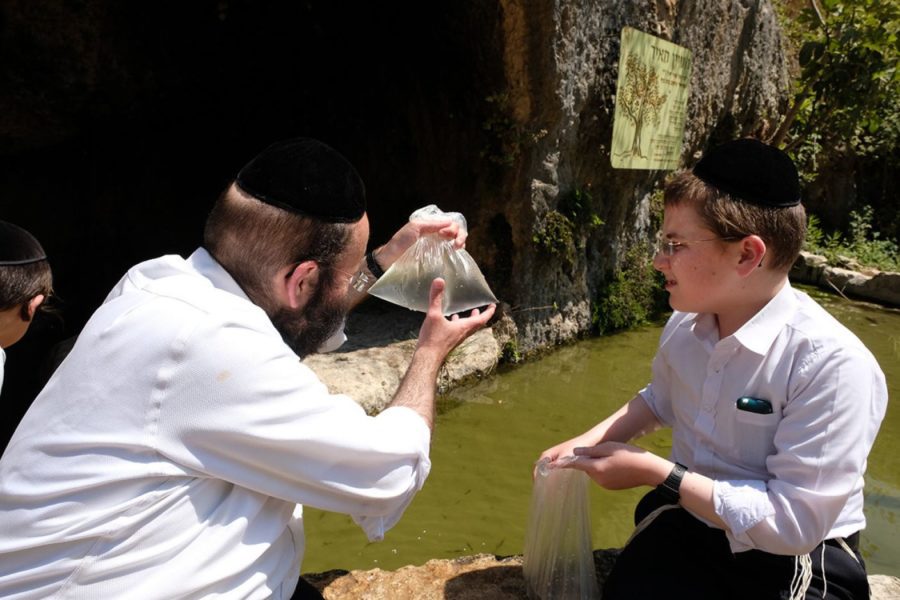
At Ein al-Ze’ira, aka Ateret Spring, they did succeed. “Served up with love” is inscribed on the picnic table next to the empty pool, supplied by “Binyamin Tourism” – named for the territory allotted to that tribe in the Bible. It’s hard to think of any greater irony. Only the huge Palestinian flag waving in the wind high up in the new city of Rawabi reminds us where we are.
Our journey ends at the Ein al-Qus spring, now also a Jewish “convert” that’s been renamed Ma’ayan Meir, below the village of Nabi Saleh, best known for its anti-occupation protests. Some soldiers are guarding an ultra-Orthodox father from Modi’in Ilit, who is here with his two children. The trio is busy scooping minnows out of the water with plastic bags. We asked the soldiers who is banned from coming here. “Arabs,” one of them replied immediately, adding, “This place is only for Jews.”
The words of a song by Yoram Taharlev are engraved on a plaque in the shade of a fig tree: “A piece of heaven, a slice of sky / Nothing do I ask only a small stone / On which to lay my head / In the shadow of the olive tree / And rest for 40 years.”




